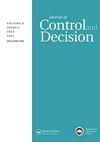Equilibrium analysis for multi-defender Stackelberg security games under a logit tie-breaking rule
IF 1.8
4区 工程技术
Q3 AUTOMATION & CONTROL SYSTEMS
引用次数: 0
Abstract
AbstractWe introduce a general multi-defender Stackelberg security game where multiple independent defenders jointly protect a same set of targets from being attacked by a common attacker. In the game, Strong Stackelberg Equilibrium is fundamentally problematic, because the notion of ‘breaking ties in defender's favour’ is no longer well defined, as we must specify which defender will receive the favour. To address this issue, we define a new equilibrium concept under a newly defined tie-breaking rule. We characterise Logit Stackelberg Multi-Defender Equilibrium, corresponding to a logit tie-breaking rule, as well as an equivalent Nash Equilibrium among defenders, and exhibit algorithms for computing the equilibrium solutions. We find that Logit Stackelberg Multi-Defender Equilibrium and its' equivalent Nash Equilibrium may not exist, which motivates us to find an approximate equilibrium. We design a revised exclusion algorithm to find the approximate ε-Nash Equilibrium in which no defender gains more than ε by deviating.KEYWORDS: Multi-defender security gametie-breaking rulelogit Stackelberg multi-defender equilibriumNash equilibriumexclusion method AcknowledgmentsThe authors thank the editor and the anonymous referees for their valuable comments and suggestions, which greatly helped improve the content and presentation of this article.Disclosure statementNo potential conflict of interest was reported by the author(s).Additional informationFundingThe paper is supported by the National Natural Science Foundation of China [grant numbers 61572095, 61877007] and Department of Science and Technology of Shanxi Province [grant numbers 20210302124303, 202203021222251].Notes on contributorsLing ChenLing Chen received the B.S. degree in statistics from Shandong University, Weihai and the Ph.D. degree in mathematics from Dalian University of Technology. Starting from 2021, she is working as a lecturer at Taiyuan Normal University. Her current research includes security game, optimisation and decision-making.Mingchu LiMingchu Li received the B.S. degree in mathematics from Jiangxi Normal University, in 1983, the M.S. degree in applied science from the University of Science and Technology Beijing, in 1989, and the Ph.D. degree in mathematics from the University of Toronto, in 1997. He was an Associate Professor at the University of Science and Technology Beijing, from 1989 to 1994. He was engaged in the research and development of information security at Long View Solution Inc. and Compute Ware Inc., from 1997 to 2002. Since 2002, he has been a Full Professor with the School of Software, Tianjin University. He has been at the School of Software Technology, Dalian University of Technology, as a Full Professor, a Ph.D. Supervisor, and the Vice Dean. His main research interests include theoretical computer science and cryptography. His other research interests include graph theory, network security, and game theory.logit平局规则下多防御者Stackelberg安全博弈的均衡分析
摘要本文介绍了一种通用的多防御者Stackelberg安全博弈,其中多个独立的防御者联合保护同一组目标免受共同攻击者的攻击。在游戏中,强Stackelberg均衡从根本上是有问题的,因为“打破有利于防守方的关系”的概念不再被很好地定义,因为我们必须明确哪个防守方会得到帮助。为了解决这个问题,我们在一个新定义的平局规则下定义了一个新的均衡概念。我们描述了Logit Stackelberg多防御者均衡,对应于Logit平局打破规则,以及防御者之间的等效纳什均衡,并展示了计算平衡解的算法。我们发现Logit Stackelberg多防御均衡及其等价纳什均衡可能不存在,这促使我们寻找一个近似均衡。我们设计了一种改进的排除算法,以求出防守方不因偏离而获得大于ε的近似ε-纳什均衡。关键词:多防御者安全博弈破局规则逻辑学Stackelberg多防御者均衡纳什均衡排除法感谢编者和匿名审稿人提出的宝贵意见和建议,极大地完善了本文的内容和表达方式。披露声明作者未报告潜在的利益冲突。基金资助:国家自然科学基金项目[资助号:61572095,61877007]和山西省科学技术厅[资助号:20210302124303,202203021222251]。陈玲,山东威海大学统计学学士学位,大连理工大学数学博士学位。从2021年开始,她将在太原师范大学担任讲师。她目前的研究方向包括安全博弈、优化和决策。李明初,1983年获江西师范大学数学学士学位,1989年获北京科技大学应用科学硕士学位,1997年获加拿大多伦多大学数学博士学位。1989年至1994年,他在北京科技大学担任副教授。1997年至2002年,他在Long View Solution Inc.和Compute Ware Inc.从事信息安全的研究和开发。2002年起任天津大学软件学院正教授。他曾任大连理工大学软件技术学院教授、博士生导师、副院长。主要研究方向为理论计算机科学和密码学。他的其他研究兴趣包括图论、网络安全和博弈论。
本文章由计算机程序翻译,如有差异,请以英文原文为准。
求助全文
约1分钟内获得全文
求助全文
来源期刊

Journal of Control and Decision
Mathematics-Control and Optimization
CiteScore
2.80
自引率
17.60%
发文量
76
 求助内容:
求助内容: 应助结果提醒方式:
应助结果提醒方式:


